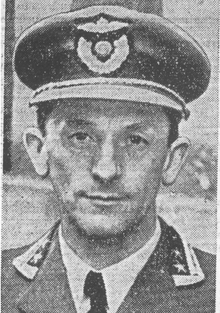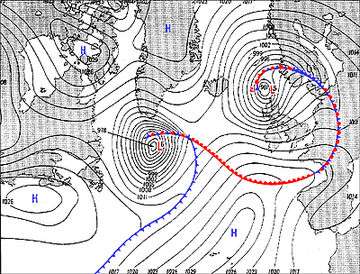Sverre Petterssen
Sverre Petterssen (19 February 1898 – 31 December 1974) was a Norwegian meteorologist, prominent in the field of weather analysis and forecasting[1].
Sverre Petterssen | |
|---|---|
 Sverre Petterssen in Norwegian uniform | |
| Born | 19 February 1898 |
| Died | 31 December 1974 (aged 76) |
| Nationality | Norwegian |
| Citizenship | United States |
| Alma mater | Bergen School of Meteorology |
| Known for | D-Day weather forecast |
| Scientific career | |
| Fields | Mathematics and Meteorology |
| Institutions | MIT |
| Doctoral students | James Murdoch Austin |
| Influences | Tor Bergeron |
Early life
Born in Norway into a humble family, he paid for his higher education by working at the telegraph office, and a nursery provided by the armed forces that he joined as a recruit. He studied in Bergen where he met Tor Bergeron during a lecture, and was so impressed by his analysis of a 1922 storm that he joined the Bergen School of Meteorology in 1923. In the late 1920s he worked at the Geophysical Institute in Tromsø, northern Norway.
Career
After school, he remained a weather officer in the Norwegian Air Force until 1939. He went to the US in 1935, lecturing on Norwegian meteorological theories to the US Navy and Caltech. In 1939, he was hired by MIT as head of the meteorology department, and wrote two important books there: Weather analysis and forecasting (1940) and Introduction to Meteorology (1941).
With the invasion of Norway, Petterssen returned to Europe and offered his services in England to the Met Office, on loan from the Norwegian Air Force. During World War II, he served as a weather forecaster for bombing raids and special operations.
He is most remembered for his work in what has been called the most significant weather forecast in history, the D-Day Forecast, where he contributed significantly to the postponement of D-day by one day. Three groups of meteorologists gave advice to General Dwight Eisenhower, and D-Day was originally planned for 5 June 1944. But he got big trouble with academically untrained competitors, especially from the United States, who believed that the weather was repeated – and had found a weather recurring pattern in the 20s that they felt was positive. And General Dwight D. Eisenhower was relying on his men. "Pettersen, which was not always as diplomatic, made it clear that this was nonsense and quasi science but Eisenhower was convinced, and the invasion would take place on 5 June. But at the morning meeting on 4 June Pettersen presented a weather map showing a storm on 5 June. To strong protests from the American quasi-meteorologist, D-Day was postponed.[2][3]
The German war fleet was laid in Port: They thought it could not get any invasion because of the storm.
But the Norwegian meteorologist knew his meteorology: His analysis showed a 36-hour gap between two storms the morning of 6 June – just enough to make the giant attack with more than 100,000 soldiers, planes, paratroopers and boats."The forecast provided by Sverre Petterssen caused Eisenhower to decide at 0430 on 4 June to postpone D-day to 6 June. Initially it was proposed to postpone the operation to 19 June.[3]

On 19 June the worst storm to date in the century struck the English channel. If D-Day had been launched on 5 June as originally planned, the Allied casualties would probably have been much higher, and even higher if launched on 19 June.
Aftermath
In retrospect, Americans claimed – including in movies – it was their meteorologists heroes who saved the situation, and only in 1974, shortly before his death, Sverre Pettersen came with his version – documenting a violent quarrel.
The American Meteorological historian James Fleming also honored Pettersen in a report 30 years later – in 2004.[4]
Awards
- 1965 Awarded the prestigious International Meteorological Organization Prize from the World Meteorological Organization.[5]
- 1969 Symons Gold Medal of the Royal Meteorological Society
References
- Fleming, James Rodger. "Sverre Petterssen, the Bergen School, and the forecasts for D-Day." Proceedings of the International Commission on History of Meteorology 1.1 (2004): 75-83.
- https://www.academia.edu/5899420/Sverre_Petterssen_and_the_contentious_and_momentous_weather_forecasts_for_D-Day
- Harald Vikøyr (26 December 2016). "Værkrangel før D-dagen". Verdens Gang.
- https://www.academia.edu/5899420/Sverre_Petterssen_and_the_contentious_and_momentous_weather_forecasts_for_D-Day
- "Winners of the IMO Prize". World Meteorological Organization. Archived from the original on 22 November 2015. Retrieved 8 December 2015.
External links
- James R. Fleming (2004). "Sverre Petterssen, the Bergen School and the Forecasts for D-Day" (PDF). Proceedings of International Commission on History of Meteorology.